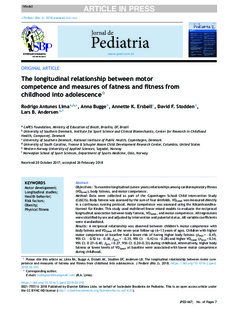| dc.contributor.author | Lima, Rodrigo Antunes | |
| dc.contributor.author | Bugge, Anna | |
| dc.contributor.author | Ersbøll, Annette Kjær | |
| dc.contributor.author | Stodden, David F. | |
| dc.contributor.author | Andersen, Lars Bo | |
| dc.coverage.spatial | Denmark, Copenhagen | nb_NO |
| dc.date.accessioned | 2019-02-19T14:55:22Z | |
| dc.date.available | 2019-02-19T14:55:22Z | |
| dc.date.created | 2018-07-15T12:43:32Z | |
| dc.date.issued | 2018 | |
| dc.identifier.citation | Lima, R. A., Bugge, A., Ersbøll, A. K., Stodden, D. F. & Andersen, L. B. (2018). The longitudinal relationship between motor competence and measures of fatness and fitness from childhood into adolescence. Jornal de Pediatria. | nb_NO |
| dc.identifier.issn | 0021-7557 | |
| dc.identifier.uri | http://hdl.handle.net/11250/2586364 | |
| dc.description.abstract | Objectives
To examine longitudinal (seven years) relationships among cardiorespiratory fitness (VO2peak), body fatness, and motor competence.
Method
Data were collected as part of the Copenhagen School Child Intervention Study (CoSCIS). Body fatness was assessed by the sum of four skinfolds. VO2peak was measured directly in a continuous running protocol. Motor competence was assessed using the Körperkoordinationtest für Kinder. This study used multilevel linear mixed models to evaluate the reciprocal longitudinal association between body fatness, VO2peak, and motor competence. All regressions were stratified by sex and adjusted by intervention and pubertal status. All variable coefficients were standardized.
Results
A reciprocal relationship was observed between children's motor competence with body fatness and VO2peak at the seven-year follow-up (6–13 years of age). Children with higher motor competence at baseline had a lower risk of having higher body fatness (βboys = −0.45, 95% CI: −0.52 to −0.38; βgirls = −0.35, 95% CI: −0.42 to −0.28) and higher VO2peak (βboys = 0.34, 95% CI: 0.27–0.40; βgirls = 0.27, 95% CI: 0.20–0.33) during childhood. Alternatively, higher body fatness or lower levels of VO2peak at baseline were associated with lower motor competence during childhood.
Conclusions
These data suggest motor competence, body fatness, and VO2peak demonstrate reciprocal relationships across childhood (6–13 years of age). Interventions addressing motor competence, cardiorespiratory fitness, and body fatness in early childhood are recommended, as intervention effects are likely to be enhanced because of the mutual reciprocal associations between these three variables. | nb_NO |
| dc.language.iso | eng | nb_NO |
| dc.publisher | Elsevier | nb_NO |
| dc.rights | Attribution-NonCommercial-NoDerivatives 4.0 Internasjonal | * |
| dc.rights.uri | http://creativecommons.org/licenses/by-nc-nd/4.0/deed.no | * |
| dc.title | The longitudinal relationship between motor competence and measures of fatness and fitness from childhood into adolescence | nb_NO |
| dc.title.alternative | Relação longitudinal entre a coordenação motora e as medidas de gordura e aptidão física da infância à adolescência | nb_NO |
| dc.type | Journal article | nb_NO |
| dc.type | Peer reviewed | nb_NO |
| dc.description.version | publishedVersion | nb_NO |
| dc.rights.holder | © 2018 Published by Elsevier Editora Ltda. on behalf of Sociedade Brasileira de Pediatria. | nb_NO |
| dc.subject.nsi | VDP::Medisinske Fag: 700::Idrettsmedisinske fag: 850 | nb_NO |
| dc.source.pagenumber | 1-7 | nb_NO |
| dc.source.volume | In Press, Corrected Proof | nb_NO |
| dc.source.journal | Jornal de Pediatria | nb_NO |
| dc.identifier.doi | 10.1016/j.jped.2018.02.010 | |
| dc.identifier.cristin | 1597353 | |
| cristin.unitcode | 203,5,2,0 | |
| cristin.unitname | Avdeling for lærarutdanning og idrett - Sogn og Fjordane | |
| cristin.ispublished | true | |
| cristin.fulltext | original | |
| cristin.qualitycode | 1 | |

